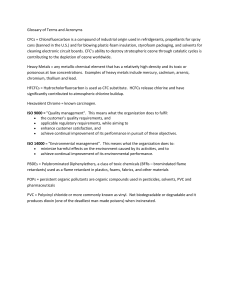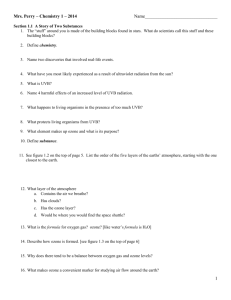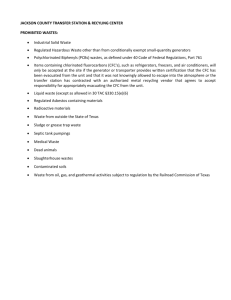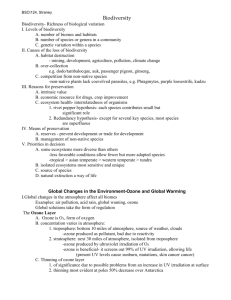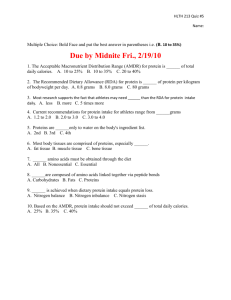Heat Transfer & Atmospheric Science Presentation
advertisement
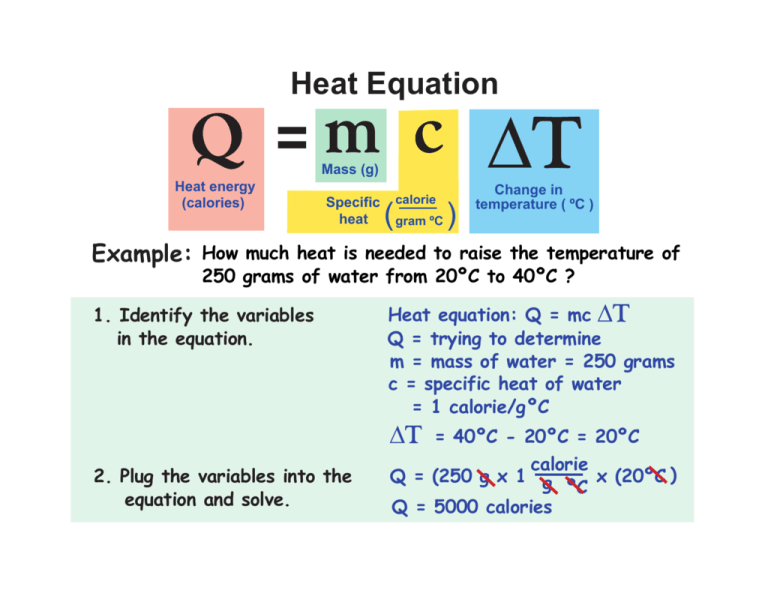
Heat Equation Heat energy (calories) Example: Mass (g) Specific heat calorie ( gram ºC ) Change in temperature ( ºC ) How much heat is needed to raise the temperature of 250 grams of water from 20ºC to 40ºC ? 1. Identify the variables in the equation. 2. Plug the variables into the equation and solve. Heat equation: Q = mc Q = trying to determine m = mass of water = 250 grams c = specific heat of water = 1 calorie/g ºC = 40ºC - 20ºC = 20ºC calorie Q = (250 g x 1 g x (20ºC ) ºC Q = 5000 calories Differences in Specific Heat HIGH SPECIFIC HEAT Temperature goes up 1ºC 100 g Water 100 calories LOW SPECIFIC HEAT Temperature goes up 20ºC 100 g Iron 100 calories When the same amount of heat is added to 100 grams of water and 100 grams of iron, the iron's temperature gain is 20 times the temperature gain of the water. Specific heat is inversely related to temperature gain Conduction Conduction is the transfer of heat by the direct contact of particles of matter. The molecules in the hot cup of liquid transfer their heat energy to the molecules in the cold spoon. Convection Convection is the transfer of heat by the actual motion of a fluid (liquid or gas) in the form of currents. Danger! Radiation Radiation is heat transfer by electromagnetic waves. Electromagnetic radiation from the sun heats Earth. SUN A Seabreeze Convection Cycle High Low Air expands Air compresses Low High Chlorofluorocarbons (CFCs)! and Ozone Depletion 1 The ozone layer protects Earth from ultraviolet light. 2 CFC's reach the stratosphere, destroying ozone. 3 O2 doesn't block ultraviolet light from the sun. UVB rays UVB rays CFC CFC O2 UVB CFC UVB O2 O2 Energy in the Atmosphere What happens to the incoming solar radiation? 5% Scattered by atmosphere 3% Absorbed by ozone in the atmosphere (almost all of the ultraviolet light) Sun 22% Reflected by clouds 17% Absorbed by atmospheric gases water vapor & dust 3% Reflected by the Earth's surface 50% Absorbed by Earth's surface Why Does Earth Have Seasons? June N January or S o th e u t rn H he em rn i He s p h e r e mis phe re N or S o th e u t rn H he em rn i He s p h e r e mis phe re Earth's orbit around the sun is almost a perfect circle. Earth has seasons because it spins on its axis at an angle. When the northern hemisphere is tilted toward the sun in June, the sun's rays are more intense. When the northern hemisphere is tilted away from the sun in January, the sun's rays are more diffuse. Global Surface Wind Patterns H H = High pressure L = Low pressure L H Pola r g We Trad e Trad e Prev ailin L erlie Prev ailin L H East H sterl ies 30º Wind s s 0º sterl East 60º Wind g We Pola r s erlie ies s 30º 60º ~ Southern Oscillation The El Nino Pacific Ocean Pacific Ocean Indonesia Current flows west Peru The usual pattern of current flow Coast of Peru Normal current direction Up-welling cold currents containing nutrients Usually, cold water from ocean depths flows up to the surface along the coast of Peru. Indonesia Current reverses direction and flows east Peru The current reverses direction ~ during El Nino. Warm water Coast of Peru Nutrients blocked by the warm water ~ the warm water current During El Nino, acts like a lid over the cold water. The Rainshadow Effect 20º C Prevailing wind direction Fertile land 40º C Desert 40º C
